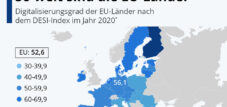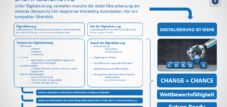Digitalization is either crap or you can make crap out of it - from high-tech to high-risk: the lessons from Nike's digital transformation
Language selection 📢
Published on: August 15, 2024 / Update from: August 15, 2024 - Author: Konrad Wolfenstein

Digitalization is either crap or you can make crap out of it - from high-tech to high-risk: The lessons from Nike's digital transformation - Image: Xpert.Digital
🚀 Change of strategy at NIKE: digital, direct and data-driven
💻➡️💩 In 2020, NIKE began a transformation of the company that brought profound changes in structure and strategic direction. These measures were taken in order to better meet the challenges of the time and secure future growth. Three key areas in particular were reformed: the elimination of product categories, the shift to a direct-to-consumer (DTC) business instead of wholesale, and the change in the marketing model to a centralized, data-driven and digital focus.
🗑️ Elimination of product categories
One of the most controversial decisions was the elimination of traditional product categories. This decision was reportedly recommended by consulting firm McKinsey and was aimed at eliminating duplication of effort within a complex matrix organization, as well as optimizing processes and reducing costs. It was believed that a data-driven model could replace the previous knowledge and expertise built up in the category-led product and brand development process. However, within six months, this led to hundreds of employees being laid off and the loss of years of valuable expertise. The focus was switched from product-specific categories such as running, football, basketball and fitness to a gender-oriented structure, divided into women's, men's and children's products.
This change proved detrimental as it resulted in a lack of innovation and product development. The negative impact on NIKE's sales and market position forced the company to reintroduce the original categories as "Fields of Play" after disappointing quarterly results in order to avoid having to openly admit the previous mistake.
🔄 End of wholesale dominance
Another significant change was the strategic realignment from wholesale to DTC business. The goal was to reduce wholesale as the second most important source of revenue and make direct digital sales (DTC) the main source. This vision marked a radical departure from the previous focus on sustainable growth, achieved through a strong market presence and brand-leading products.
Numerous agreements with local business partners were abandoned and the number of employees in the sales teams was reduced. This led to tensions and conflicts with long-standing trading partners worldwide. NIKE had high hopes for the growth of digital sales and invested significant resources in digital marketing. For years, billions of dollars have been poured into programmatic advertising and performance marketing to drive e-commerce and drive faster-growing traffic to the e-commerce platform. Nevertheless, the targeted growth rate could not be maintained. The slow resurgence of traditional brick-and-mortar retail (B&M business) post-pandemic also contributed to growth in the DTC business falling short of expectations.
🛠️ Adaptation of the marketing model
In terms of marketing, NIKE implemented a new, centralized and data-driven strategy. The focus here was on digital orientation. The goal was to use data to address customers more effectively and to better control marketing measures. This change was accompanied by the increased use of big data and algorithms to precisely analyze consumer behavior and develop marketing strategies tailored to it.
However, it became clear that this approach alone was not enough. Despite investing in digitalization and restructuring the marketing model, NIKE was unable to overcome all challenges. Brick-and-mortar stores gradually regained importance and it became clear that a balance between digital and traditional sales was necessary.
🔍 Review and current developments
Looking back, it is clear that NIKE's transformation brought both opportunities and risks. The pandemic and the associated changes in consumer behavior had favored the short-term success of the DTC strategy. In the long term, however, it became clear that the complete dependence on a highly digitalized model and the abandonment of proven structures were not without consequences.
The crisis revealed the weak points of the new model: difficulties in innovative product design, the strain on long-term partnerships and the failure to achieve a growth rate in the digital sector. NIKE had to recognize that a purely data-driven model could not replace the deep knowledge and experience built over years in the categories.
Recently, NIKE has therefore reintegrated some of the original elements of the traditional business strategy. The categories have been reintroduced as “Fields of Play” and there is a return to a balanced mix of wholesale and DTC business. The approach of linking digital and brick-and-mortar business channels appears to be emerging as an effective way to promote both innovation and market presence.
🚀 NIKE as a lesson
NIKE's transformation can serve as a lesson for other companies considering a similar transition. It shows that having the courage to change is important, but at the same time there is also a need not to completely throw away strengths and proven processes. A balanced approach that takes both innovations and traditions into account seems to be the key to sustainable success.
For the future, NIKE plans to continue to invest heavily in digitalization, while taking into account the lessons learned and not neglecting stationary sales channels. It remains exciting to see how the company will develop further and whether it will succeed in creating a stable basis for long-term growth based on a balanced model. NIKE will certainly have to rely on a deep understanding of market needs and flexible adaptation to changing conditions.
📣 Similar topics
- 📣 NIKE's Change: From Product Categories to DTC 🔄
- 🚀 Direct sales instead of wholesale at NIKE!
- 📊 Data-driven marketing strategy at NIKE 📈
- ⚖️ Balance between digital and traditional sales 🌐🛍️
- 🔄 Return to proven structures at NIKE 🔙
- 📉 Lack of innovation and decline in sales at NIKE 👟📊
- 🏷️ New business model: women's, men's and children's products 👫👧
- 💼 Tensions in wholesale: NIKE's new strategy 💥🤝
- 📍 “Fields of Play”: NIKE brings back categories 🎯
- 🔍 Insights into NIKE's transformation journey 👀📖
#️⃣ Hashtags: #NIKETransformation #DirectToConsumer #DigitalerVertrieb #FieldsOfPlay#MarketingStrategie
⚾⚽🏉 Sales & Marketing Learnings: About the addiction to performance marketing – when “Nike” lost its lead with inefficient online advertising

Sales & Marketing Learnings: About the addiction to performance marketing – when “Nike” lost its lead with inefficient online advertising – Image: Xpert.Digital
The case of Nike impressively illustrates how a former sports icon can maneuver itself into the sidelines through a failed marketing strategy. For decades, Nike built its image through gigantic sponsorship deals and unforgettable advertising campaigns. These measures not only shaped the perception of the brand, but also created a strong emotional bond between the brand and its consumers.
By pivoting to digital direct sales and performance marketing in 2020, Nike sought to adapt to changing market conditions, particularly during lockdowns. At first, the move seemed effective as online sales increased and inventory began to move. But this strategy had serious long-term disadvantages.
More about it here:
📱🚀🔍 Xpert.Digital - PDF collection: Focus on digital marketing and AI
Focus on digital marketing and AI
- Marketing worldwide
- Dialogue marketing in Germany – includes, among other things, email marketing
- B2C influencer marketing
- search engines
- Online Advertising
🚨📈 Beware of the trap: Digitalization is not a playground - ads, DTC sales and the harsh reality of performance marketing

Beware of the trap: Digitalization is not a playground - Ads, DTC sales and the harsh reality of performance marketing - Image: Xpert.Digital
Digitalization has turned many things in the business world upside down. Above all, direct-to-consumer (DTC) sales, which bypass wholesale and retail trade and enable direct contact with customers, seem at first glance to be a lucrative strategy. But reality shows that it is not nearly as easy as it sounds. High investment costs, intense competitive pressure and challenges in performance marketing pose significant problems for companies.
DTC sales promise great advantages: by selling directly over the Internet, the middlemen can be bypassed and costs can be saved. It also enables a closer relationship with the customer and offers the opportunity to collect valuable data about purchasing behavior. But this ideal is often difficult to achieve in reality.
More about it here:
We are there for you - advice - planning - implementation - project management
☑️ Industry expert, here with his own Xpert.Digital industry hub with over 2,500 specialist articles
I would be happy to serve as your personal advisor.
You can contact me by filling out the contact form below or simply call me on +49 89 89 674 804 (Munich) .
I'm looking forward to our joint project.
Xpert.Digital - Konrad Wolfenstein
Xpert.Digital is a hub for industry with a focus on digitalization, mechanical engineering, logistics/intralogistics and photovoltaics.
With our 360° business development solution, we support well-known companies from new business to after sales.
Market intelligence, smarketing, marketing automation, content development, PR, mail campaigns, personalized social media and lead nurturing are part of our digital tools.
You can find out more at: www.xpert.digital - www.xpert.solar - www.xpert.plus


























